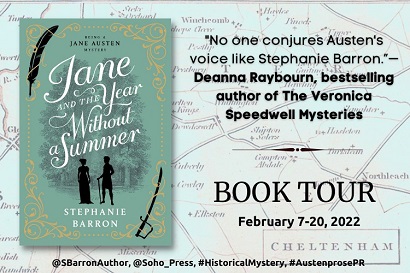She and Cassandra take lodgings at Mrs. Potter’s, a boarding house on the High Street whose other guests are an eccentric and motley bunch, including a beautiful invalid heiress with a waspish temper, the companion who attends her in her wheeled chair, a middle-aged brother-sister pair whose self-centeredness knows no bounds, a young woman who gives elocution lessons to actors, and more. Meanwhile, Jane has trouble setting aside thoughts of Mr. Raphael West, a handsome past admirer, and wonders why he hasn’t renewed their acquaintance.
In her fourteenth Jane Austen mystery, Stephanie Barron smoothly interweaves real events from Jane Austen’s life with a fictional crime scenario involving her fellow lodgers, at least one of whom has murder in mind. You may be excused for forgetting, early on, about the novel’s intended genre, since the plot ambles along nicely for a while without any deadly happenings.
 |
| author Stephanie Barron |
Jane and Cassandra sample the waters at the Pump House (which taste absolutely vile!), and her visit to a local physician gets her blood boiling, a reaction that women especially will identify with. The Austen sisters become curious about the mysterious “Beauty in the Bath Chair” and her reasons for being in Cheltenham. Make no mistake, though, this genteel mystery has teeth, and Jane, with her famously astute observations on human nature, is there to untangle it all.
The novel is written in the form of a period piece authored by Jane herself, complete with Regency-era diction, vocabulary, and spellings, plus historical footnotes contributed by the book’s “editor.” Through them, we’re told (or reminded, for those in the know) about the meaning of the title: following the eruption of Mt. Tambora in the Dutch East Indies the previous year, the weather across Europe in 1816 was unnaturally cold and dismal. Footnotes in historical fiction only work well in certain instances, and this is one of them.
Despite Jane’s literary brilliance (and deductive success, as imagined here), it’s impossible, while reading this story, to set aside the sorrowful fact that her life—and by implication, perhaps this series as well—is drawing to a close. The ending, while bittersweet, feels just right for the book, and for readers who haven’t sampled Jane’s previous adventures, there are thirteen others to anticipate.
Stephanie Barron's Jane and the Year Without a Summer is published by Soho Press this month (I reviewed it from a NetGalley copy for the author's blog tour).











Thanks for sharing your thoughts, Sarah. What a well-written review. I am glad you enjoyed it too. Barron channels Austen so well that I feel like Jane is talking to me. One more book in the series, that will be a bittersweet end. Sniff.
ReplyDeleteThanks for your kind comments, Laurel Ann - I agree, the narrative voice works so well here. Thanks also for the information on the series. I'll be looking out for the next and final book, despite knowing what the future holds for Jane.
DeleteThanks as always, Sarah. This book sounds lovely.
ReplyDeleteIt was!
Delete